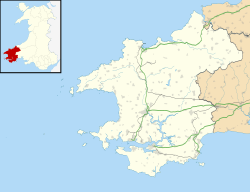| Minwear | |
|---|---|
 Church of St Womar | |
Location within Pembrokeshire | |
| OS grid reference | SN038130 |
| Community |
|
| Principal area | |
| Country | Wales |
| Sovereign state | United Kingdom |
| Police | Dyfed-Powys |
| Fire | Mid and West Wales |
| Ambulance | Welsh |
Minwear is a former parish and village in the community of Martletwy, in the county of Pembrokeshire, Wales, on the Eastern Cleddau river, 4+1⁄2 miles (7.2 km) southwest of the town of Narberth. Its history can be traced back to the 12th century. Wood from Minwear Forest supported local industries from mediaeval times to the 19th century.

